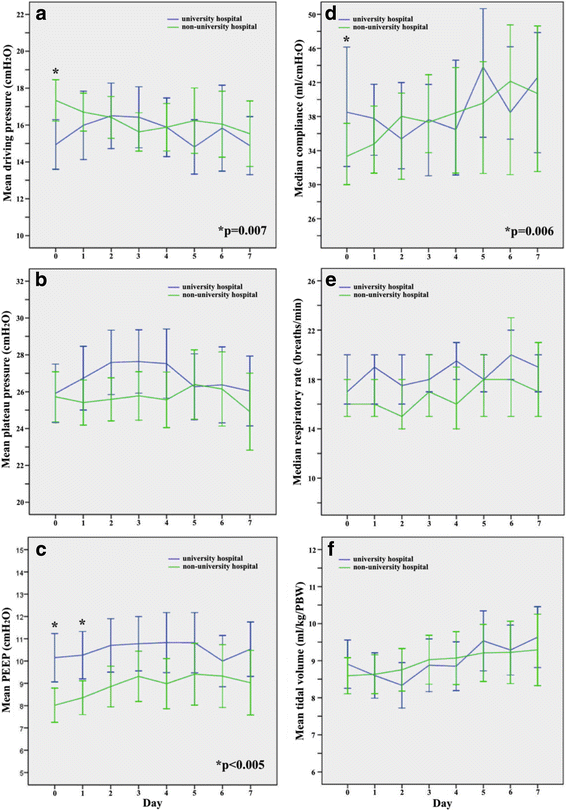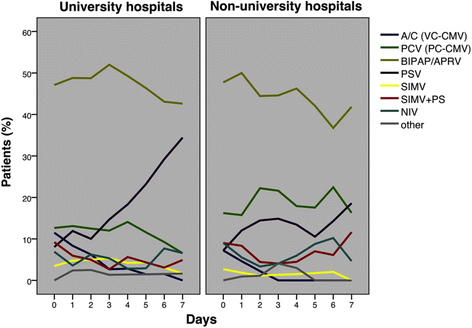Outcome of acute respiratory distress syndrome in university and non-university hospitals in Germany
- PMID: 28554331
- PMCID: PMC5448143
- DOI: 10.1186/s13054-017-1687-0
Outcome of acute respiratory distress syndrome in university and non-university hospitals in Germany
Abstract
Background: This study investigates differences in treatment and outcome of ventilated patients with acute respiratory distress syndrome (ARDS) between university and non-university hospitals in Germany.
Methods: This subanalysis of a prospective, observational cohort study was performed to identify independent risk factors for mortality by examining: baseline factors, ventilator settings (e.g., driving pressure), complications, and care settings-for example, case volume of ventilated patients, size/type of intensive care unit (ICU), and type of hospital (university/non-university hospital). To control for potentially confounding factors at ARDS onset and to verify differences in mortality, ARDS patients in university vs non-university hospitals were compared using additional multivariable analysis.
Results: Of the 7540 patients admitted to 95 ICUs from 18 university and 62 non-university hospitals in May 2004, 1028 received mechanical ventilation and 198 developed ARDS. Although the characteristics of ARDS patients were very similar, hospital mortality was considerably lower in university compared with non-university hospitals (39.3% vs 57.5%; p = 0.012). Treatment in non-university hospitals was independently associated with increased mortality (OR (95% CI): 2.89 (1.31-6.38); p = 0.008). This was confirmed by additional independent comparisons between the two patient groups when controlling for confounding factors at ARDS onset. Higher driving pressures (OR 1.10; 1 cmH2O increments) were also independently associated with higher mortality. Compared with non-university hospitals, higher positive end-expiratory pressure (PEEP) (mean ± SD: 11.7 ± 4.7 vs 9.7 ± 3.7 cmH2O; p = 0.005) and lower driving pressures (15.1 ± 4.4 vs 17.0 ± 5.0 cmH2O; p = 0.02) were applied during therapeutic ventilation in university hospitals, and ventilation lasted twice as long (median (IQR): 16 (9-29) vs 8 (3-16) days; p < 0.001).
Conclusions: Mortality risk of ARDS patients was considerably higher in non-university compared with university hospitals. Differences in ventilatory care between hospitals might explain this finding and may at least partially imply regionalization of care and the export of ventilatory strategies to non-university hospitals.
Keywords: Acute respiratory distress syndrome; Biphasic positive airway pressure; Care setting; Driving pressure; Mechanical ventilation.
Figures





Comment in
-
Care at a non-university hospital: an independent risk factor for mortality in ARDS?Crit Care. 2017 Jul 31;21(1):195. doi: 10.1186/s13054-017-1778-y. Crit Care. 2017. PMID: 28756768 Free PMC article. No abstract available.
References
-
- Lewandowski K, Metz J, Deutschmann C, Preiss H, Kuhlen R, Artigas A, Falke KJ. Incidence, severity, and mortality of acute respiratory failure in Berlin, Germany. Am J Respir Crit Care Med. 1995;151:1121–5. - PubMed
-
- Bein T, Weber-Carstens S, Goldmann A, Müller T, Staudinger T, Brederlau J, Muellenbach R, Dembinski R, Graf BM, Wewalka M, Philipp A, Wernecke KD, Lubnow M, Slutsky AS. Lower tidal volume strategy (≈3 ml/kg) combined with extracorporeal CO2 removal versus ‘conventional’ protective ventilation (6 ml/kg) in severe ARDS: the prospective randomized Xtravent-study. Intensive Care Med. 2013;39(5):847–56. doi: 10.1007/s00134-012-2787-6. - DOI - PMC - PubMed
Publication types
MeSH terms
LinkOut - more resources
Full Text Sources
Other Literature Sources
Medical

